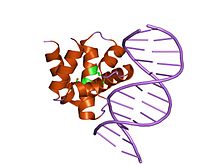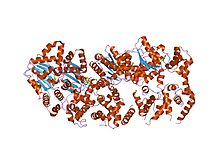DnaA
| Chromosomal replication initiator protein dnaA | |
|---|---|
| Identifiers | |
| Organism |
(str. K-12 substr. MG1655) |
| Symbol | DnaA |
| Entrez | 948217 |
| RefSeq (Prot) | NP_418157.1 |
| UniProt | P03004 |
| Other data | |
| Chromosome | genome: 3.88 - 3.88 Mb |
| Bac_DnaA_C | |||||||||
|---|---|---|---|---|---|---|---|---|---|

crystal structure of dnaa domainiv complexed with dnaabox dna
|
|||||||||
| Identifiers | |||||||||
| Symbol | Bac_DnaA_C | ||||||||
| Pfam | PF08299 | ||||||||
| Pfam clan | CL0123 | ||||||||
| InterPro | IPR013159 | ||||||||
| SCOP | 1j1v | ||||||||
| SUPERFAMILY | 1j1v | ||||||||
|
|||||||||
| Available protein structures: | |
|---|---|
| Pfam | structures |
| PDB | RCSB PDB; PDBe; PDBj |
| PDBsum | structure summary |
| Bac_DnaA | |||||||||
|---|---|---|---|---|---|---|---|---|---|

structure of amppcp-bound dnaa from aquifex aeolicus
|
|||||||||
| Identifiers | |||||||||
| Symbol | Bac_DnaA | ||||||||
| Pfam | PF00308 | ||||||||
| Pfam clan | CL0023 | ||||||||
| InterPro | IPR013317 | ||||||||
| PROSITE | PDOC00771 | ||||||||
| SCOP | 1j1v | ||||||||
| SUPERFAMILY | 1j1v | ||||||||
|
|||||||||
| Available protein structures: | |
|---|---|
| Pfam | structures |
| PDB | RCSB PDB; PDBe; PDBj |
| PDBsum | structure summary |
DnaA is a protein that activates initiation of DNA replication in bacteria. It is a replication initiation factor which promotes the unwinding of DNA at oriC. The onset of the initiation phase of DNA replication is determined by the concentration of DnaA. DnaA accumulates during growth and then triggers the initiation of replication. Replication begins with active DnaA binding to 9-mer (9-bp) repeats upstream of oriC. Binding of DnaA leads to strand separation at the 13-mer repeats. This binding causes the DNA to loop in preparation for melting open by the helicase DnaB.
The active form DnaA is bound to ATP. Immediately after a cell has divided, the level of active DnaA within the cell is low. Although the active form of DnaA requires ATP, the formation of the oriC/DnaA complex and subsequent DNA unwinding does not require ATP hydrolysis.
The oriC site in E. coli has three AT rich 13 base pair regions (DUEs) followed by four 9 bp regions with the sequence TTAT(C or A)CA(C or A)A. Around 10 DnaA molecules bind to the 9 bp regions, which wrap around the proteins causing the DNA at the AT-rich region to unwind. There are 8 DnaA binding sites within oriC, to which DnaA binds with differential affinity. When DNA replication is about to commence, DnaA occupies all of the high and low affinity binding sites. The denatured AT-rich region allows for the recruitment of DnaB (helicase), which complexes with DnaC (helicase loader). DnaC helps the helicase to bind to and to properly accommodate the ssDNA at the 13 bp region; this is accomplished by ATP hydrolysis, after which DnaC is released. Single-strand binding proteins (SSBs) stabilize the single DNA strands in order to maintain the replication bubble. DnaB is a 5'→3' helicase, so it travels on the lagging strand. It associates with DnaG (a primase) to form the only primer for the leading strand and to add RNA primers on the lagging strand. The interaction between DnaG and DnaB is necessary to control the longitude of Okazaki fragments on the lagging strand. DNA polymerase III is then able to start DNA replication.
...
Wikipedia
